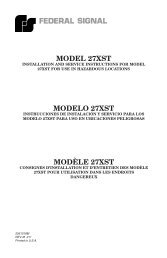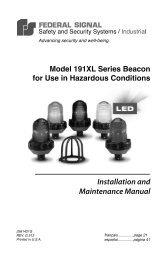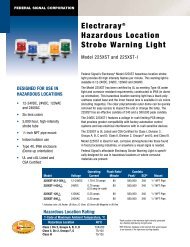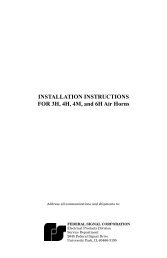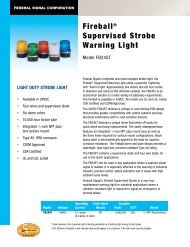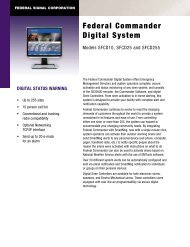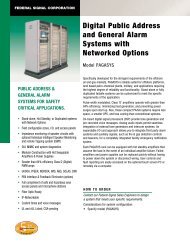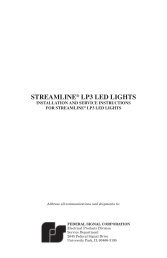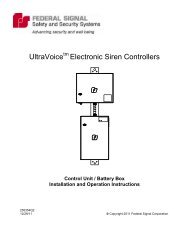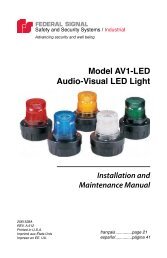MODEL 300MB-SD - Federal Signal
MODEL 300MB-SD - Federal Signal
MODEL 300MB-SD - Federal Signal
You also want an ePaper? Increase the reach of your titles
YUMPU automatically turns print PDFs into web optimized ePapers that Google loves.
Failure to follow all safety precautions and<br />
instructions may result in property damage,<br />
serious injury, or death to you or others.<br />
SAFETY MESSAGE TO INSTALLERS<br />
Peoples lives depend on your safe installation of our<br />
products. It is important to follow all instructions shipped<br />
with the products. This device is to be installed by a trained<br />
electrician who is thoroughly familiar with the National<br />
Electric Code and will follow the NEC guidelines as well as<br />
local codes.<br />
The selection of the mounting location for the device,<br />
its controls and the routing of the wiring is to be accomplished<br />
under the direction of the Facilities Engineer and<br />
the Safety Engineer. In addition, listed below are some<br />
other important safety instructions and precautions you<br />
should follow:<br />
• Although your signaling system is working properly,<br />
it may not be completely effective. People may not hear or<br />
heed your warning signal. You must reconize this fact and<br />
proceed with due caution.<br />
• Read and understand all instructions before installing<br />
or operating this equipment.<br />
• Do not connect or service this unit when power is on.<br />
• Optimum sound distribution will be severely reduced<br />
if any objects are in front of the speaker. You should ensure<br />
that the front of the speaker is clear of any obstructions.<br />
• All effective warning speakers produce loud sounds<br />
which may cause, in certain situations, permanent hearing<br />
loss. You should take appropriate precautions such as wearing<br />
hearing protection.<br />
• All effective warning speakers produce loud sounds,<br />
which may cause, in certain situations, permanent hearing<br />
loss. The device should be installed far enough away<br />
from potential listeners to limit their exposure while still<br />
maintaining its effectiveness. The OSHA Code of <strong>Federal</strong><br />
Regulations 1910.95 Noise Standard provides guidelines<br />
which may be used regarding permissible noise exposure<br />
levels.<br />
• After installation, test the sound system to ensure<br />
proper operation.<br />
• Show these instructions to your Safety Engineer and<br />
all operating personnel and then file them in a safe place<br />
and refer to them when maintaining and/or reinstalling the<br />
unit.<br />
• Establish a procedure to routinely check the sound<br />
system for proper activation and operation.<br />
SECTION III<br />
INSTALLATION<br />
3-1<br />
3-1. UNPACKING.<br />
After unpacking the Model <strong>300MB</strong>, examine<br />
it for damage that may have occurred in transit. If<br />
the equipment has been damaged, do not attempt to<br />
install or operate it, file a claim immediately with the<br />
carrier stating the extent of the damage. Carefully<br />
check all envelopes, shipping labels and tags before<br />
removing or destroying them. Before attempting to<br />
install the CommCenter, be sure that all parts listed<br />
in the KIT CONTENTS LIST have been supplied.<br />
3-2. KIT CONTENTS.<br />
Qty. Description Part No.<br />
1 Plug, 10 Position 140A332-10<br />
1 Plug, 17 Position 140A332-17<br />
3-3. INPUT CONFIGURATION.<br />
The CommCenter can be configured for remote<br />
activation in four ways:<br />
• Normally open latching contacts.<br />
• Normally open momentary contacts.<br />
• Normally closed latching contacts.<br />
• Normally closed momentary contacts.<br />
The unit is factory set to be activated by closing<br />
a normally open latching contact between the<br />
associated input and circuit ground. When activated<br />
the message will continue to loop and repeat. It will<br />
stop as soon as it is deactivated. When configured for<br />
momentary activation, the message will continue to<br />
loop and repeat until the input is deactivated. Upon<br />
deactivation of the input, it will play the entire message<br />
before stopping.<br />
Each of the six inputs can be individually configured<br />
by moving a two position jumper on a three<br />
position header. See table 3-1 for a list of the Priority<br />
Tones, their associated jumper designation and their<br />
marking as shown on the printed circuit board silkscreen.<br />
3-4. CONTROL CIRCUITRY.<br />
A. The control circuitry in the CommCenter<br />
has a built-in priority level feature. If a given message<br />
is already sounding when a higher priority<br />
message is activated, the higher priority message<br />
automatically overrides the lower priority message.<br />
When the higher priority message is deactivated, the<br />
lower priority message is initiated as long as it is still<br />
activated. The messages are prioritized with Priority<br />
Tone 1 having the highest priority down to Priority<br />
Tone 6. The cascade input has the lowest level of<br />
priority.



